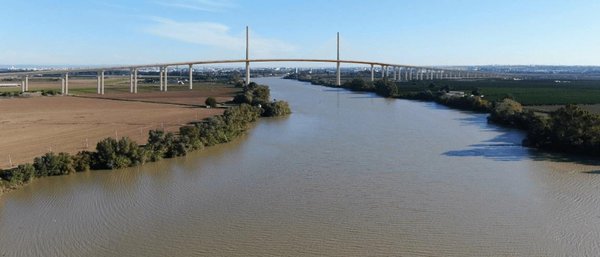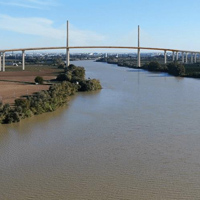The Spanish Ministry of Transport and Sustainable Mobility has approved a large section of the SE-40 ring road near Seville, which will include what will become the country's longest viaduct. The permit, published on November 6th in the Official Gazette (BOE), applies to the 5.07 km stretch between Dos Hermanas-Palomares and Coria del Río.
The construction of the new bridge for the Ministry of Transport and Sustainable Mobility is coordinated by the public engineering firm Ineco. The detailed structural design is being carried out by a joint venture between Tylin Spain SL and MC2 Estudio de Ingeniería, while preliminary concept studies have been carried out by Ayesa. The estimated budget for the work is $742 million (€688.11 million).
 Visualization of the SE-40 cable-stayed bridge over the Guadalquivir River (Ministry of Transport and Sustainable Mobility)
Visualization of the SE-40 cable-stayed bridge over the Guadalquivir River (Ministry of Transport and Sustainable Mobility)
The centerpiece of the project is a series of viaducts with a total length of 3.5 km, including a cable-stayed bridge that will span the Guadalquivir River without intermediate supports in the water. The main span will be 366 m and the structure will provide a minimum vertical clearance of 70.8 m to allow the passage of large ships. The deck will be 42 m wide and provide space for four lanes in each direction as well as cycle and pedestrian paths and 72,000 m² of green space.

Official rendering showing the cable-stayed structure and panoramic viewpoints (Ministry of Transport and Sustainable Mobility)
The aim of the new intersection is to relieve congestion on the SE-30, which currently serves as the main circulation route for the Seville metropolitan area. Of the 75 km planned for the SE-40, only 38 km are currently in use. Once completed, the viaduct will exceed the 1812 Constitution Bridge in Cadiz, which opened in 2015, and will be 3,092 m long with a headroom of 69 m.
The project has been classified as urgent under Spanish road legislation. Current activities include geotechnical investigations and dynamic monitoring contracts. Construction tenders are expected in 2026, with an expected opening in 2029, subject to tender and work plan. Further work will include improvements to the southern roundabout in Coria del Río to improve traffic flow and safety, addressing long-standing local concerns about congestion during peak hours.
